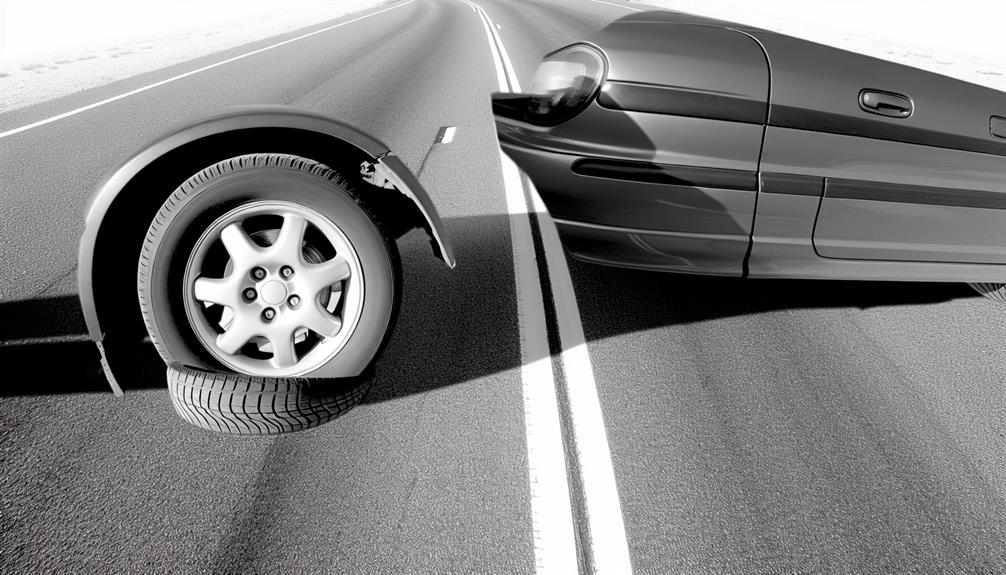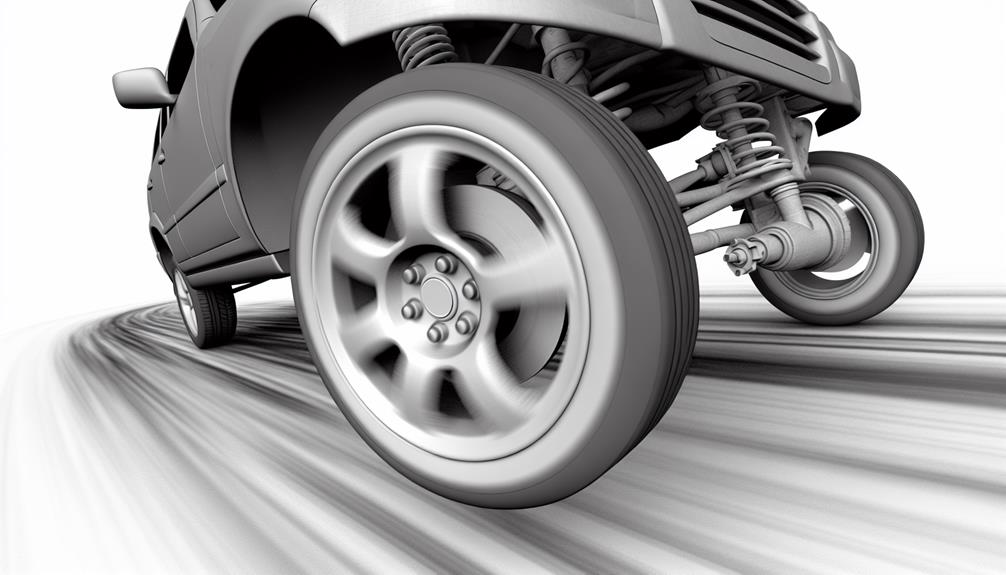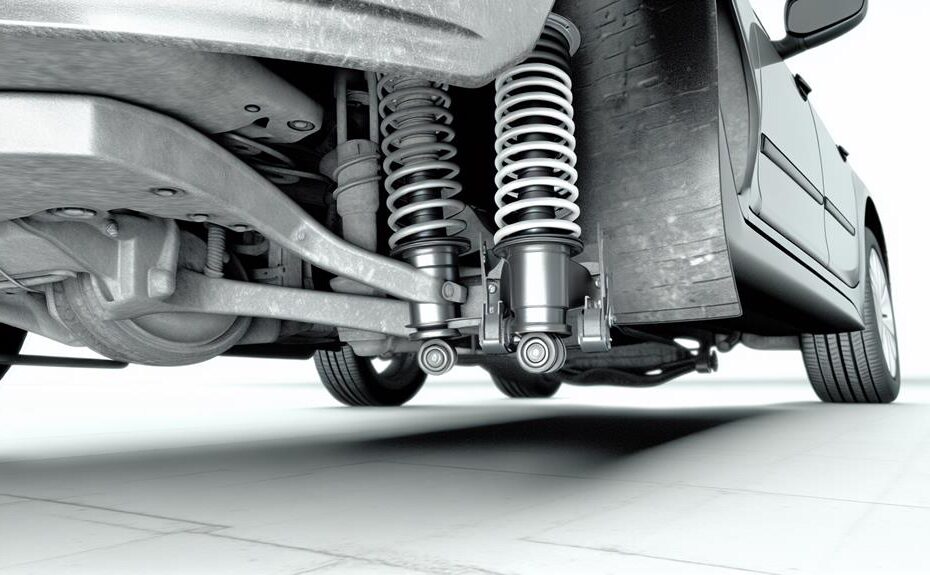Are you tired of feeling every bump and pothole on the road? Perhaps you've noticed that your car's suspension is causing some issues. One common problem that many drivers experience is uneven tire wear. This can occur when the suspension components are worn or damaged, causing the tires to make uneven contact with the road surface.
But uneven tire wear is just the tip of the iceberg when it comes to suspension problems. In this discussion, we will explore some of the most common issues that can arise with your car's suspension and why they occur.
So, buckle up and get ready to uncover the mysteries behind your bumpy ride.
Key Takeaways
- Improper wheel alignment and neglecting suspension maintenance can cause uneven tire wear.
- Excessive bouncing or diving may be caused by shock absorber malfunction or spring fatigue.
- Vehicle pulling to one side can be a result of alignment problems or worn suspension components.
- Noisy or squeaky suspension can be caused by lack of lubrication, worn out bushings, or loose/damaged components.
Uneven Tire Wear
If you notice uneven tire wear on your vehicle, it's important to address this issue promptly to prevent further damage and ensure optimal performance. Uneven tire wear is often a result of improper wheel alignment or suspension maintenance.
Wheel alignment refers to the adjustment of the angles of the wheels, ensuring that they're perpendicular to the ground and parallel to each other. When the alignment is off, it can cause uneven tire wear, leading to decreased tire life and compromised handling.
Suspension maintenance, on the other hand, involves inspecting and maintaining the various components of the suspension system, such as the shocks, struts, and springs. These components play a crucial role in providing a smooth and comfortable ride, as well as ensuring proper tire contact with the road surface. Neglecting suspension maintenance can result in excessive tire wear, reduced stability, and compromised handling.
To address the issue of uneven tire wear, it's recommended to visit a professional mechanic who can accurately diagnose the problem and perform the necessary wheel alignment or suspension maintenance procedures. Regular maintenance and inspections are key to preventing uneven tire wear and ensuring the longevity and performance of your vehicle's tires.
Excessive Bouncing or Diving
Experiencing excessive bouncing or diving in your vehicle's suspension? This issue can be attributed to a shock absorber malfunction or spring fatigue. When the shock absorbers, which are responsible for controlling the movement of the suspension, malfunction, they fail to dampen the impact of bumps and road irregularities. This results in a bouncy ride, making it difficult to maintain control of your vehicle.
On the other hand, spring fatigue occurs when the coil springs lose their elasticity over time, causing them to sag or become weak. This can lead to excessive diving, particularly during braking or acceleration, as the springs struggle to support the weight of your vehicle.
To address these issues, it's essential to have your shock absorbers and springs inspected by a qualified mechanic. They'll be able to diagnose the problem and determine whether a repair or replacement is necessary. It's important to address these issues promptly as driving with a malfunctioning suspension can compromise your safety and the handling of your vehicle.
Vehicle Pulling to One Side

When your vehicle consistently pulls to one side while driving, it may indicate an issue with the alignment or tire pressure. Alignment problems can cause your car to veer off to one side, making it difficult to maintain a straight path. This can occur due to misaligned wheels caused by hitting potholes, curbs, or other objects on the road.
Worn suspension components can also contribute to the pulling effect. Over time, the suspension system can deteriorate, causing unequal weight distribution and resulting in the vehicle pulling to one side.
If you notice your car pulling to one side, it's important to have it inspected by a professional mechanic. They'll be able to assess the alignment and suspension components to determine the cause of the issue. Correcting alignment problems may involve adjusting the camber, caster, and toe settings of the wheels. For worn suspension components, replacement may be necessary to restore proper balance and eliminate the pulling sensation.
Addressing these issues promptly will ensure a safer and more comfortable driving experience.
Noisy or Squeaky Suspension
Suspension issues can manifest as irritating noises or squeaks coming from your vehicle. These noises can be more than just an annoyance; they can be an indication of underlying problems with your car's suspension system. Here are three possible causes for noisy or squeaky suspension:
- Lubrication problems: Lack of proper lubrication can lead to friction between the suspension components, resulting in squeaks and noises. Check the suspension system for any signs of dried-out or insufficient lubrication.
- Worn out bushings: Bushings are rubber or polyurethane components that provide cushioning and flexibility to the suspension system. Over time, these bushings can wear out and lose their effectiveness, causing squeaking sounds. Inspect the bushings for signs of damage or deterioration.
- Loose or damaged suspension components: Loose or damaged suspension components, such as bolts, nuts, or control arms, can cause vibrations and rattling noises. Ensure that all suspension components are securely fastened and free from damage.
If you notice any noisy or squeaky suspension, it's important to address the issue promptly. Ignoring these sounds can lead to further damage and compromise the safety and performance of your vehicle. Consult a professional mechanic to diagnose and resolve the problem to ensure a smooth and quiet ride.
Loss of Steering Control

If you have been noticing any issues with noisy or squeaky suspension, it's crucial to address them promptly to prevent a potential loss of steering control. A loss of steering control can be caused by various factors, including a steering system malfunction or alignment problems. When the suspension components are worn or damaged, it can affect the stability and responsiveness of your steering system, leading to a loss of control over your vehicle.
A steering system malfunction occurs when there's a failure in one or more components of the steering system. This can include issues with the power steering pump, steering rack, or steering column. If any of these components are faulty, it can result in a loss of steering control, making it difficult to turn the wheels or maintain a straight line.
Alignment problems can also contribute to a loss of steering control. When your wheels aren't properly aligned, it can cause uneven tire wear and affect the handling of your vehicle. This can lead to a loss of control, especially at higher speeds or when making sharp turns.
To prevent a loss of steering control, it's essential to regularly inspect and maintain your suspension system. This includes checking for any signs of wear or damage, such as leaking shocks or worn-out bushings. It's also important to have your wheels aligned regularly to ensure optimal steering performance.
Addressing any issues with your suspension promptly and maintaining proper alignment can help prevent a potential loss of steering control, ensuring your safety and the safety of others on the road.
Frequently Asked Questions
How Often Should I Have My Car's Suspension Inspected and Serviced?
You should have your car's suspension inspected and serviced regularly to prevent issues. Proper car maintenance includes checking for suspension repair needs, which can help ensure a smooth and safe ride.
Can Poor Road Conditions Contribute to Suspension Issues?
Driving on poor road conditions can take a toll on your car's suspension. Potholes and bumps can cause wear and tear, shortening its lifespan. Additionally, improper tire pressure can also negatively impact suspension performance.
What Are the Signs of Worn-Out Suspension Components?
Regular maintenance is important to prevent suspension wear. Signs of worn-out components include uneven tire wear, excessive bouncing or swaying, and a rough ride. Causes of suspension wear can include potholes, rough roads, and lack of lubrication.
Can a Misaligned Suspension Cause Damage to Other Parts of the Vehicle?
A misaligned suspension can wreak havoc on your vehicle. It's like a domino effect – impacting stability and causing long-term consequences. Don't let this problem go unchecked; get it fixed ASAP!
How Can I Determine if the Suspension Issue Is Due to Worn-Out Shocks or Struts?
To determine if your suspension issue is due to worn-out shocks or struts, you can perform a visual inspection for leaks or damage, test the bounce of the vehicle, and listen for unusual noises while driving.
Conclusion
In conclusion, it's crucial to address any issues with your car's suspension promptly. Ignoring these problems can lead to uneven tire wear, excessive bouncing or diving, vehicle pulling to one side, noisy or squeaky suspension, and even loss of steering control.
Just like a sturdy bridge requires a strong foundation, a well-maintained suspension is essential for a smooth and safe ride. So, don't neglect your car's suspension and ensure its proper functioning for a comfortable and secure journey.
